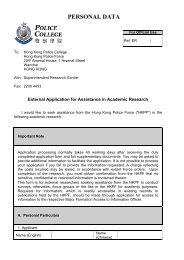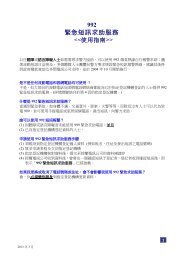警察培訓系列四:刑事調查訓練的學習理論 - 香港警務處
警察培訓系列四:刑事調查訓練的學習理論 - 香港警務處
警察培訓系列四:刑事調查訓練的學習理論 - 香港警務處
Create successful ePaper yourself
Turn your PDF publications into a flip-book with our unique Google optimized e-Paper software.
警 察 培 訓 系 列 4 - 刑 事 調 查 訓 練 的 學 習 理 論<br />
二 零 一 一 年 四 月<br />
第 四 部 分 : 總 結<br />
現 今 數 碼 世 界 瞬 息 萬 變 , 社 會<br />
對 於 機 構 及 個 人 的 才 能 , 要 求 愈 來<br />
愈 高 , 往 日 沿 用 的 正 統 訓 練 未 必 能<br />
妥 為 配 合 。 有 鑑 於 此 , 學 院 遂 改 變<br />
以 傳 統 課 堂 培 訓 為 主 的 方 式 , 把 課<br />
堂 培 訓 與 輔 導 自 學 兩 者 加 以 結 合 。<br />
再 者 , 今 日 的 罪 案 面 貌 隨 着 科 技 日<br />
新 月 異 而 時 有 改 變 , 我 們 必 須 令 人<br />
員 懂 得 如 何 自 學 , 並 鼓 勵 他 們 與 其<br />
他 罪 案 調 查 人 員 保 持 聯 繫 / 建 立 關<br />
係 網 絡 。 此 舉 正 好 與 教 授 特 定 破 案<br />
技 巧 的 方 式 相 輔 相 成 。<br />
由 此 可 見 , 要 評 估 學 習 成 效 ,<br />
除 了 須 考 慮 學 員 學 到 多 少 相 關 知 識<br />
/ 技 巧 外 , 也 應 顧 及 他 們 是 否 保 持<br />
觸 覺 敏 銳 , 與 信 息 及 知 識 來 源 保 持<br />
連 繫 , 在 有 需 要 時 能 及 時 掌 握 有 用<br />
資 料 。<br />
警 察 學 院 相 信 , 正 式 訓 練 仍 然<br />
是 不 可 或 缺 的 , 以 便 保 證 人 員 質 素<br />
和 進 行 審 計 , 以 及 就 警 隊 專 業 才 能<br />
提 供 可 作 審 計 的 資 料 。<br />
參 考 書 目 / 資 料<br />
1 Anderson, L. W. & Krathwohl, D. R. (Eds)<br />
(2001). A taxonomy for learning, teaching,<br />
and assessing: A revision of Bloom’s<br />
taxonomy of educational objectives. New<br />
York: Addison Wesley Longman.<br />
2 Barrows, H. S. & Tamblyn, R. M. (1980).<br />
Problem-based learning: An approach to<br />
medical education. New York: Springer.<br />
3 Boyatzis, R. E. (1982). The Competent<br />
Manager. John Wiley.<br />
4 Brockett, R. G. and Hiemstra, R. (1991). “A<br />
conceptual framework for understanding<br />
self-direction in adult learning” in Self-<br />
Direction in Adult Learning: Perspectives<br />
on Theory, Research, and Practice. London<br />
and New York: Routledge. Reproduced in<br />
the informal education archives: http://<br />
www.infed.org/archives/e-texts/hiemstra_<br />
self_direction.htm, accessed 2010-09-29.<br />
5 Centre for Teaching. “ Team-based<br />
Learning (TBL): Effective Teaching in<br />
Large and Small Class Settings”, http://<br />
10.50.251.21:8080/0b1d355b6a2d/<br />
comfort-file/5195_be46_98cd00ce_<br />
c9fc _11df_93a7_0019b9e8e768/<br />
Intro%20to%20Team-Based%20Learning.<br />
pdf, accessed 2010-09-27.<br />
6 Chartered Institute of Personnel and<br />
Development (2005). “Change Agenda”,<br />
April 2005, http://www.cipd.co.uk/NR/<br />
rdonlyres/52AF1484-AA29-4325-8964-<br />
0A7A1AEE0B8B/0/train2lrn0405.pdf,<br />
accessed 2010-10-27.<br />
7 I n t e r n a t i o n a l e We i t e r b i l d u n g u n d<br />
Entwicklung gGmbH, Capacity Building<br />
I n t e r n a t i o n a l G e r m a n y ( 2 0 0 3 ) .<br />
“Competency-based Training: Compilation<br />
of seminar subject matter: Training-the-<br />
Trainers”. Beitrage aus der Praxis der<br />
beruflichen Bildung Nr 1, http://starwww.inwent.org/starweb/inwent/docs/<br />
Lehrbrief_01_engl.pdf, accessed 2010-<br />
10-27.<br />
8 Jonassen, D. H. (1999). Designing<br />
constructivist learning environments. In<br />
C. M. Reigeluth (Ed.), Instructional design<br />
theories and models: A new paradigm<br />
of instructional theory, Volume II, 215-<br />
239. Mahwah, NJ: Lawrence Erlbaum<br />
Associates.<br />
13 Michaelsen, Larry, A B Knight and L D<br />
Fint (Eds)(2002). Team-Based Learning:<br />
A Transformative Use of Small Groups.<br />
Praeger Publishers.<br />
14 van Raaij, Marieke (2008). “What makes<br />
Gen Y tick” 11 December 2008, http://<br />
www.eu.gov.hk/english/cmps/files/<br />
cmps_20081211b_What_Makes_Gen_Y_<br />
Tick.pdf, accessed 2010-09-27.<br />
15 Savery, John R. and Thomas M Duffy<br />
(1995). “Problem Based Learning: An<br />
instructional model and its constructivist<br />
framework” in Educational Technology, 35,<br />
31-38. Also in B. Wilson (Ed) Constructivist<br />
Learning Environments: Case Studies in<br />
Instructional Design, 1995, 135-150,<br />
http://crlt.indiana.edu/publications/duffy_<br />
publ6.pdf, accessed 2010-09-27.<br />
16 Savery, John R. (2006). “Overview of<br />
Problem-based Learning: Definitions<br />
and Distinctions” in The Interdisciplinary<br />
Journal of Problem-based Learning, Vol 1,<br />
No. 1 Spring 2006, http://www.ijpbl.org/,<br />
accessed 2010-09-27.<br />
17 Siemens, George (2004). “Connectivism:<br />
A Learning Theory for the Digital Age” 12<br />
December 2004, http://www.elearnspace.<br />
org/Articles/connectivism.htm, accessed<br />
2010-09-28.<br />
18 Siemens, George (2006). “Connectivism:<br />
Learning and Knowledge Today” in Global<br />
Summit 2006: Technology Connected<br />
Futures, http://dspace.edna.edu.au/<br />
dspace/bitstream/2150/34771/1/<br />
gs2006_siemens.pdf, accessed 2010-09-<br />
28.<br />
9 Knowles, Malcolm (1975). Self-Directed<br />
Learning. Chicago: Follet.<br />
10 Knowles, Malcolm (1984). Andragogy in<br />
Action. San Francisco: Jossey-Bass.<br />
11 Knowles, Malcolm (1990). The Adult<br />
Learner: A Neglected Species (4th Ed).<br />
Houston: Gulf Publishing Company, Book<br />
Division.<br />
12 Massachusetts Institute of Technology,<br />
Training and Development, http://web.<br />
mit.edu/training/trainers/guide/design/<br />
lifetime.html, accessed 2010-10-20.<br />
19 Siemens, George (2006a). “Knowing<br />
K n o w l e d g e ” , h t t p : / / 1 0 . 5 0 . 2 5 1 . 2<br />
1 : 8 0 8 0 / 0 b 1 d 3 5 5 b 6 a 2 d / c o m f o r t-<br />
f i l e / 4 7 2 5 _ c 9 1 6 _ 2 e c 8 6 3 c 2 _<br />
cad2_11df _beaf_0019b9e8e768/<br />
KnowingKnowledge_LowRes.pdf, accessed<br />
2010-09-28.<br />
20 “Team-based Learning: An Alternative to<br />
Lecture-based Learning”, http://www.regis.<br />
edu/content/rhpharm/pdf/Learning_With_<br />
TBL.pdf, accessed 2010-09-27.<br />
© 香 港 警 察 學 院 版 權 所 有<br />
培 訓 教 材 只 供 自 學 用 途<br />
禁 止 非 授 權 用 途 及 披 露<br />
A C e n t r e o f E x c e l l e n c e i n P o l i c e Tr a i n i n g a n d D e v e l o p m e n t 專 業 ‧ 卓 越 8

















